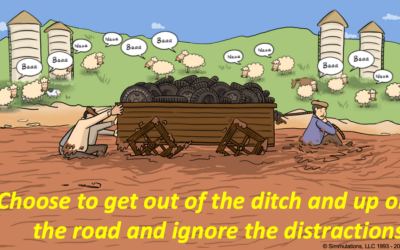This “What Would Peter Drucker Do” is the second in a series of posts I will do to share about key organizational development frameworks. Sure, they are Old School ideas, but very solid and fully developed frameworks that are generally ignored. The first was anchored to Tom Peters, one of my most favorite consultants.
I’m frustrated. And I have felt that way for a LONG time. In my early years, I had hope we could improve organizations through training and consulting but Gallup, Arbinger, Bersin and much other research clearly shows NOTHING has really improved.
I am waiting for AI to start culling the bad managers from the workplace after having read a LOT of different books about organizations and leadership and management over the past 50 years. We have the metrics, we just need some effective actions. And Peter would support that, for sure.
 Peter Drucker, often hailed as the “father of modern management,” introduced numerous principles and practices that should influence organizational performance and leadership today. One of his most influential books, “The Practice of Management”, was published in 1954 so his ideas have been around for a long time.
Peter Drucker, often hailed as the “father of modern management,” introduced numerous principles and practices that should influence organizational performance and leadership today. One of his most influential books, “The Practice of Management”, was published in 1954 so his ideas have been around for a long time.
Here are key strategies Drucker might employ to improve organizational performance and leadership:
Management by Objectives (MBO)
One of Drucker’s most enduring contributions is the concept of Management by Objectives (MBO). This approach involves setting clear, measurable goals that align with the organization’s overall objectives. And his approach involves doing things WITH people rather than TO them.
Note: Each employee participates in setting these goals, which promotes accountability and ensures that everyone understands their role in achieving the organization’s aims. Most of his approach are focused on engaging people in performance.
Steps in MBO:
- Goal Setting: Establish specific, measurable, achievable, relevant, and time-bound (SMART) goals.
- Participation: Involve employees at all levels in the goal-setting process.
- Alignment: Ensure that individual goals align with the organization’s strategic objectives.
- Evaluation: Regularly review and assess progress towards these goals.
Emphasis on Innovation and Continuous Improvement
Drucker believed that innovation is critical for productivity improvement. He advocated for systematically identifying emerging opportunities and developing the structures necessary to capitalize on them. This involves abandoning outdated practices and focusing resources on new, more productive tasks.
Strategies for Innovation:
- Systematic Abandonment: Regularly review and discontinue unproductive activities.
- Encouraging Creativity: Foster a culture where new ideas are welcomed and explored.
- Internal Entrepreneurship: Promote entrepreneurial thinking within the organization to drive innovation from within.
Decentralization and Empowerment
Drucker emphasized the importance of decentralizing decision-making and empowering employees. He believed that those closest to the work are often best positioned to make informed decisions. This approach fosters a sense of ownership, creativity, and adaptability within the organization.
Benefits of Decentralization:
- Enhanced Responsiveness: Faster decision-making at local levels.
- Increased Motivation: Employees feel more valued and engaged.
- Better Use of Local Knowledge: Decisions are made by those with the most relevant information.
Ethical Leadership and Corporate Responsibility
Drucker stressed the importance of ethical leadership and corporate social responsibility (CSR). He believed that businesses should not only focus on profitability but also on being good corporate citizens. This involves treating employees with respect, being environmentally conscious, and contributing to the well-being of the community.
Principles of Ethical Leadership:
- Integrity: Leaders should act with high moral and ethical standards.
- Transparency: Open and honest communication within the organization.
- Fairness: Treating all employees and stakeholders with fairness and respect.
Focus on Effectiveness and Efficiency
Drucker distinguished between efficiency (doing things right) and effectiveness (doing the right things). He argued that organizations should prioritize effectiveness to ensure that their efforts lead to meaningful results. This involves setting priorities, developing action plans, and holding individuals accountable for their performance.
Practices for Enhancing Effectiveness:
- Setting Priorities: Focus on the most critical tasks that align with strategic goals.
- Action Plans: Develop detailed plans to achieve desired outcomes.
- Accountability: Clearly define responsibilities and hold individuals accountable for results.
Customer-Centric Approach
Drucker believed that the primary purpose of any business is to create and retain satisfied customers. Understanding and meeting customer needs should be at the heart of any management strategy. This customer-centric approach ensures that the organization remains relevant and competitive in a constantly changing market.
I think he would have liked this one:

Customers can feel every thump and bump in their journey without understanding the systems and processes.
Implementing a Customer-Centric Strategy:
- Customer Feedback: Regularly gather and act on customer feedback.
- Value Delivery: Focus on delivering value that meets or exceeds customer expectations.
- Continuous Improvement: Constantly seek ways to improve products and services based on customer insights.
Some Peter Drucker Quotes:
The leaders who work most effectively, it seems to me, never say “I.” And that’s not because they have trained themselves not to say “I.” They don’t think “I.” They think “we”; they think “team.” They understand their job to be to make the team function. They accept responsibility and don’t sidestep it, but “we” gets the credit. This is what creates trust, what enables you to get the task done.
Knowledge has to be improved, challenged, and increased constantly, or it vanishes.
Efficiency is doing the thing right. Effectiveness is doing the right thing.
If you want something new, you have to stop doing something old
We now accept the fact that learning is a lifelong process of keeping abreast of change. In addition, the most pressing task is to teach people how to learn.
Management is doing things right; leadership is doing the right things.
The best way to predict the future is to create it.
People who do not take risks generally make about two big mistakes a year. People who do take risks generally make about two big mistakes a year.
There is nothing as useless as doing efficiently that which should not be done at all.
Innovation is the specific instrument of entrepreneurship. The act that endows resources with a new capacity to create wealth.
Management by objective works – if you know the objectives. Ninety percent of the time you do not.
Peter Drucker’s management philosophy boils down to a few key ideas that are still relevant today:
- It’s all about the people. Drucker believed managers should focus on developing employees and helping them work together effectively.
- Set clear goals and objectives. He popularized “management by objectives” (MBO) – getting everyone aligned on shared goals.
- Decentralize and empower. Drucker advocated for pushing decision-making down the org chart rather than micromanaging.
- Keep learning and innovating. He emphasized the importance of continuous improvement and adapting to change.
- Look outward. Drucker said results only matter outside the organization – like happy customers or patients. Happy employees also contribute greatly to organizational success.
The cool thing is these principles can help create organizations that are both profitable and socially responsible. By putting people first, setting clear goals, dis-un-empowering employees, and staying innovative, companies can build lasting success. It’s a holistic approach that’s still super applicable in today’s fast-changing business world.
Here is a solid article on “old school” leadership about some practical insights into how to align culture with strategy and energize employees today. https://www.strategy-business.com/blog/Leaders-should-revisit-the-works-of-three-corporate-culture-pioneers
And here are some of my related blog posts, with more to come:
#1 – What would Tom Peters Do – https://performancemanagementcompany.com/2024/07/02/what-would-tom-peters-do/
#3 – What would Frederick Taylor Do – https://performancemanagementcompany.com/2024/07/13/what-would-frederick-taylor-do/
#4 – What would Bob Mager Do – https://performancemanagementcompany.com/2024/07/17/what-would-bob-mager-do-to-improve-organizational-performance/
#5 – What would W. Edwards Deming Do? – https://performancemanagementcompany.com/2024/07/23/what-would-deming-do/
Dave Ulrich posted up a great summary of Drucker’s work in a post in LinkedIn on Nov 11, 2025. Go check it out here by clicking here.
The Truth is Out There! (so go read about it!)
—
For the FUN of It!
 Dr. Scott Simmerman is a designer of team building games and organization improvement tools.
Dr. Scott Simmerman is a designer of team building games and organization improvement tools.
Managing Partner of Performance Management Company since 1984, he is an experienced presenter and consultant who is trying to retire!! He now lives in Cuenca, Ecuador.
You can reach Scott at scott@squarewheels.com
Learn more about Scott at his LinkedIn site.
Here is a link to a press release about The Search for The Lost Dutchman’s Gold Mine teambuilding exercise and its 30 years of positively impacting people and performance.
I used Perplexity to help generate the overview of the information.
Square Wheels® is a registered trademark of Performance Management Company
The Search for The Lost Dutchman’s Gold Mine is a trademark of Performance Management Company
Square Wheels images © Performance Management Company, 1993 – 2023. All rights reserved.







0 Comments